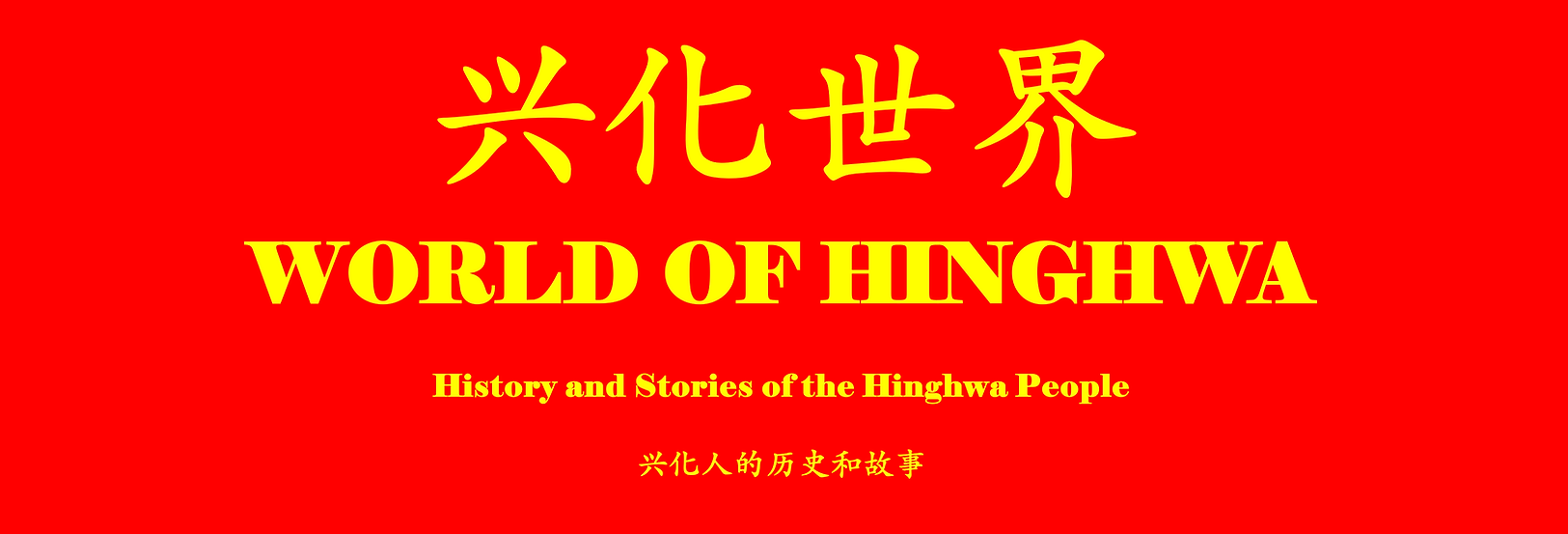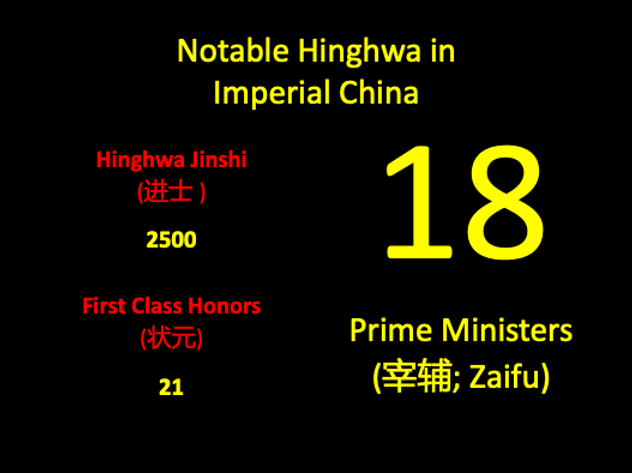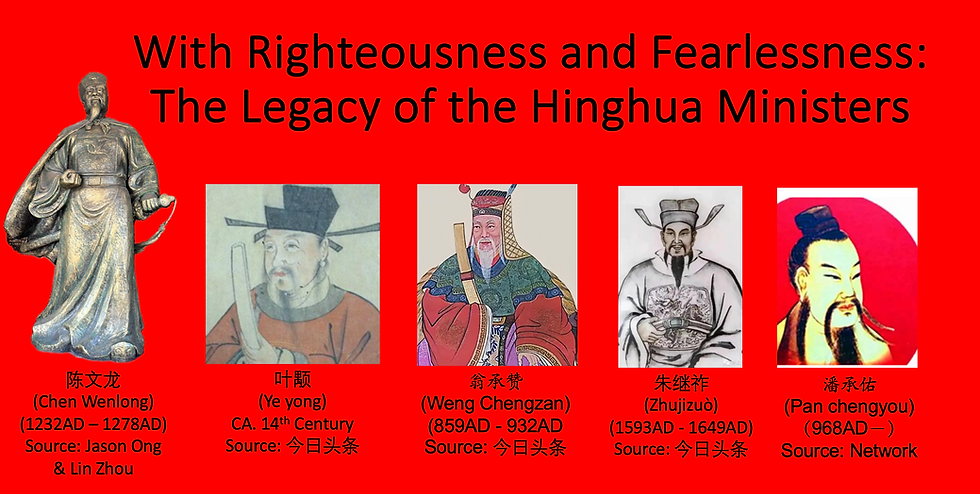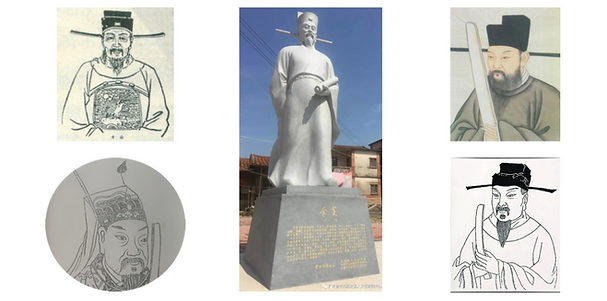

文献名邦,海滨邹鲁

Jiumulin; (九刺史)Source: Xiao Yuwan
Ancient Notable Hinghua
The Hinghua population is among the smallest in China; however, they have contributed the highest number of imperial scholars (进士) on average.
From a pool of 2,500 Hinghua Jinshi, 21 achieved the top position (Liu, F. Z., 2014). According to Professor Chen, 21 became top scholars, and 18 held the title of Zaifu (宰辅). This term generally refers to positions such as 'Premier,' 'Vice-Premier,' or 'Member of the Privy Council.' In ancient China, they were also known as Chengxiang (丞相), Zaixiang (宰相), or Mingxiang (名相).
Another term for minister was Shangshu (尚书). To determine the correct term to use, it is important to consider the context of the text from that era.
In addition to the 18 Premiers, there were 22 Prefectural or Provincial Governors (刺史; cishi) or Taishou (太守). A governor could oversee an area five to ten times the size of Singapore or larger.
Other significant positions included Keeper of the Imperial Seal (中书令) and Historian, among others. While the titles may differ from dynasty to dynasty, their roles tend to be similar. Together, they contributed to establishing Puxian, a coastal region renowned for its literature and culture, known as '文献名邦、海滨邹鲁' (Liu, F. Z., 2014).
Out of these graduates, approximately 1,500 were from Putian and served as either prefectural magistrates (知府), senior provincial government officials (知州), or county head magistrates (知县).
According to Liu, D. J. (2013), the imperial Jinshi (进士) scholars who attained the top position were the most esteemed (状元是最为风光) in ancient China. They were likely to be appointed to very high official posts.

Interest in education flourished in Puxian, which came to be recognized as a hub for imperial scholars (进士之乡) during both the Tang and Southern Song Dynasties.
In 706 AD, Puxian produced its first imperial scholar, Xue Lingzhi (薛令之), a native of Fujian. Lingzhi (683–757 AD) hailed from the village of 唐福建道长溪廉村, which corresponds to present-day Gaocen, Lian Village, Xitan Town, Fu’an City (Zhou, 2008g, pp. 118–119).
A remarkable number of talented individuals emerged from this region. Wang (2018a) noted that “98 people were included in the Siku Quanshu (四库全书),” a comprehensive imperial collection of Chinese literature, often regarded as an encyclopedia of classical knowledge.
Unsurprisingly, Wang Anshi (王安石) (1021–1086 AD) -- a prominent politician, economist, and minister—once expressed his astonishment at the large number of imperial scholars from Putian (Ruan, 2013e, p. 1).
These achievements are especially significant considering the competitive nature of the imperial examinations: out of several thousand candidates, only 20 to 30 succeeded, with only about 12% of them attaining the highest honor of being ranked first (Ruan, 2013f, p. 2).
Most of these distinguished graduates went on to serve as prefectural magistrates (知府), senior provincial officials (知州), or county magistrates (知县).
Among them, 18 rose to the rank of Zaifu (宰辅), a title often translated as “Prime Minister,” while 22 served as Prefecture Governors (刺史) or Taishou (太守).
The list of these ministers is presented chronologically by their Romanized names, without references to rank or relative significance.
Below is the list of the eighteen ministers from Putian:

The term "Zaifu" (宰辅) is translated as Premier (总理), Vice Premier (副总理), or Member of the State Council (国务院议员).
According to Professor Chen, accurately translating ancient official titles is challenging, as each dynasty had its own contextual meanings and subtleties.
One issue is that some terms are difficult to render precisely in English, as there are no direct equivalents for many ancient Chinese political roles. For clarity and simplicity, I will refer to them collectively as Premiers.
Each Premier has a unique story to tell -- some rose from modest or disadvantaged backgrounds, while others came from elite or well-established families.
For instance, some ministers benefited from privileged upbringings due to their family status.
A notable example is the Cai family, which included Cai Jing, Cai You, and Cai Bian -- collectively known as the "three Zaifu" (Prime Ministers). Ironically, this trio represented a complex blend of qualities -- some admirable, others deeply flawed. Cai Jing was notorious for his ruthlessness and treachery, even turning against his own brother, Cai Bian. Similarly, his son, Cai You, echoed his father’s infamy, showing no mercy—even toward his own father, Cai Jing.


Arrangements: Jason Ong
The legendary Justice Bao is revered by the Chinese people for his unwavering fairness and fearless commitment to justice.
This admirable character was mirrored in many Hinghwa ministers, who were also known for their righteousness, integrity, and moral courage.
Some of these ministers were accomplished writers, while others were distinguished military leaders. For instance, Minister Zhu Jizuo led Ming Dynasty forces in battle against Qing invaders (Chen, J.S., 2016). He was honored as a heroic warrior and held in high regard by the people.
Almost all of these ministers shared a common trait: they were incorruptible and steadfast in carrying out their responsibilities. Many, like Minister Pan Chengyou, were outspoken and principled, unafraid to speak their minds.
They showed no favoritism and exercised their considerable authority with impartiality, making it clear that not even members of the royal family were above the law. For example, Minister Ye Yong, a trusted advisor to the emperor, was frequently tasked with confronting corrupt officials involved in nepotism and cronyism (Chen & Huang, 2019).
Their unwavering commitment to justice sometimes invited retaliation, resulting in false accusations, demotion, dismissal, or even loss of life.
As a result, many ministers chose to resign rather than compromise their values. Minister Weng Chengzhan, for instance, opted to retire when imperial factionalism became intolerable.
These characteristics were especially evident among the Hinghua ministers featured in the Nanyang, as highlighted in their respective sections.
Twenty-Two Prefecture Governors
(二十二刺史)
As explained within the framework of the ancient administrative system, each dynasty structured its administrative regions differently, with evolving terminology and hierarchy.
A prefecture, known as Zhou (州), can be interpreted as either a state-level or sub-provincial unit, depending on the era of the dynasty.
During the Tang Dynasty, a prefecture was governed by a Cishi (刺史) -- translated as Prefecture Governor -- or by a Taishou (太守), depending on the specific rank and responsibilities.
Most of these governors held the prestigious title of Jinshi (进士; Imperial Scholar). Ancient Putian was proud to have produced twenty-two such esteemed governors, though historians believe the actual number may have been higher, as some names have likely been lost to time.
One particularly distinguished family produced nine of these governors, earning them the honorary title Jiumulin (九刺史) -- the Lin family of nine prefecture governors.
Below is the list of Hinghwa Cishi:
(Family of nine prefecture governors)
Jiumulin; (九刺史)
Source: Xiao Yuwan
Lin Pi (林披) (Patriach of the nine Lin brothers). Lin Wei (林苇) 端州刺史. Lin Zao (林藻) 江陵刺史. Lin Zhe (林著) 横州刺史. Lin Jian (林荐) 韶州刺史. Lin Ye (林晔) 通州刺史. Lin Yun (林蕴) 邵州刺史. Lin Meng (林蒙) 循州刺史. Lin Mai (林迈) 雷州刺史. Lin Ji (林蔇) 福唐刺史.
It is not common for a village to have one Cishi or governor, let alone nine in a family.
Other Cishi
Lin Xuantai (林玄泰; 636-710). (瀛州刺史). Huang An (黄岸; 680-762AD). (广西桂州刺史). Xu Wu (徐务; 713-742). (衢州刺史). Hong Gui (洪圭; 740-825). (潮州刺史).Xu Ji (许稷; ?-?). (衡州刺史). Dong Yong (董勇; ?-?). (漳州刺史). Zheng Liangshi (郑良士; 856-930). (恩州刺史). Dong Si 'an (董思安; ?-?). 南州(漳州)刺史. Chen Xian (陈铦; ?-?). (漳州刺史). Chen Wenhao (陈文颢; 932-1003). (洪州刺史).Li Xin (李欣; ?-?). 虢州(今属河南)刺史. Chen Wenxu (陈文顼; 958-992). (舒州刺史).
Source: Chen Chun Yang
According to Prof. Chen, during the Qing Dynasty era, there were only two imperial officials from Putian. They were Minister for Rites Guo Shangxian (礼部侍郎郭尚先) and Governor-General of Gansu and Shanxi Lin Yang Zu (陕甘总督林扬祖).
Amongst the many Cishi, some were extraordinary, such as Lin Pi (林披; 733 AD – 802 AD), his son Lin Zao (林藻; 765 AD – 840 AD), and Huang An (黄岸; 680 AD – 762 AD).

Five Sages of Putian
Top L: 陈俊卿 (赠) Chen Junqing (Merit); Bottom L: 龚茂良 (Gong Maoliang) Middle: Li Fu (李富);
Top R: Cai Xiang (蔡襄); Bottom R: Lin Guang Chao Source: Jason Ong & Lin Zhou

There were many notable figures in ancient Putian. However, five individuals stood out in historical memory and were said to be honored at the Temple of the Five Sages.
Unfortunately, during my trip to Putian in September 2024, I was unable to locate the temple.
Nevertheless, the temple was said to have originally been built for four sages: Gong Maoliang, Cai Xiang, Chen Junqing, and Lin Guangchao (林光朝; 1114–1178 AD). Later, Li Fu was added as the fifth sage.
Cai Xiang was a native of Fengting Town in Xianyou County, Fujian Province. A Jinshi, he was gifted in calligraphy and literature, and was an expert in tea culture, authoring many influential works.
Beyond his literary brilliance, he was also an early advocate of environmental conservation, leading efforts to plant trees along roads that stretched for hundreds of miles.
Cai Xiang was a principled and impartial official, known for his zero tolerance of corruption and misconduct among his peers. In recognition of his integrity and service, the emperor awarded him one of the highest positions in the imperial court. Upon his death, he was posthumously honored with the title "Loyalty and Benevolence" (忠惠).
Centre of Culture and Literature
In 1565, a Putian magistrate, Xu Zhice (徐执策), observed the remarkable concentration of scholars in the region. In recognition of this cultural and intellectual flourishing, he erected a plaque on both sides of the road bearing the inscription: “莆阳文献,海滨邹鲁” (Puyang Wenxian, Haibin Zou Lu), which likened Putian to Zou and Lu -- the hometowns of Confucius and Mencius -- renowned centers of learning.
Over the years, as the area underwent reconstruction and development, the inscription gradually evolved into the more familiar phrase: "文献名邦,海滨邹鲁" (Wenxian Mingbang, Haibin Zoulu)", meaning "A celebrated land of letters by the seaside, akin to Zou and Lu."
This distinguished name has been preserved and remains in use to this day.
The Leader in Health and Beauty

Just like the imperial scholars of ancient Putian who brought lasting fame to their hometown, a small but formidable group of Hinghwa entrepreneurs from Putian is doing likewise, this time, on the medical front.
Collectively, they oversee more than 8,000 hospitals, not only serving general health needs but also specialising in a range of complex medical fields.
Leading the charge are aesthetic hospitals, catering to a growing number of affluent women seeking to preserve and enhance their beauty.
If I may say so, Putian may be small, but it is helping the world stay both healthy and beautiful.
Source: Wix

© 2025. Copyright Jason Ong
作者: 王顺龙, 新加坡
All Rights Reserved
